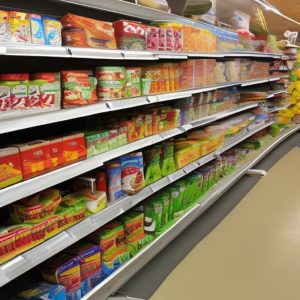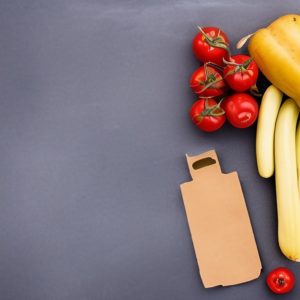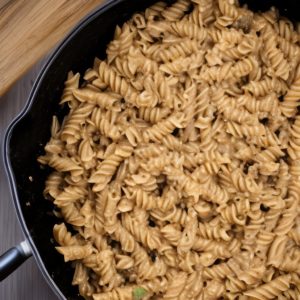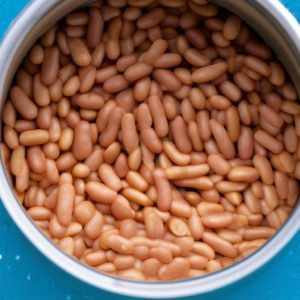P.S. Want to know when our next post lands and get our free ebook on how to live frugally? Then click the link below.
For many people, grocery shopping is a necessary evil.
It’s a chore that has to be done, but it’s also an expense that can take a serious bite out of your monthly budget.
If you’re looking for ways to trim your grocery budget without compromising on the quality of your food, here are a few tips to help you get started.
4 tips for grocery shopping on the cheap

1. Make a list—and stick to it
Impulse buys are one of the biggest money-wasters when it comes to grocery shopping – whether you’re on a tight budget or if you just like to save on your grocery bill.
Before you even set foot in the store, take a few minutes to sit down and make a list of everything you need.
Not only will this help you save money by keeping you focused on buying only what you need, but it will also save you time by preventing you from wandering up and down the aisles looking for things you may or may not need.
2. Take advantage of sales and coupons

Most stores offer some kind of sale or promotion every week, so make sure you know what’s going on before you head to the store.
And don’t forget about coupons! These days, coupons are available not only in newspapers and magazines, but also online and through store loyalty programs.
Taking advantage of sales and coupons can help you save a significant amount of money on your grocery bill each month.
3. Buy in bulk—but only when it makes sense.
Buying in bulk can be a great way to save money, but only if the item is something that you know you’ll use before it expires.
There’s no point in buying 10 pounds of chicken if it’s going to go bad before you have a chance to eat it all.
But if you have the freezer space and you know you’ll use it, then buying in bulk can be a great way to save money in the long run.
4. Stick to the perimeter of the store
The vast majority of grocery stores are laid out in the same general way: fresh produce, meat, and dairy are along the perimeter while processed foods and packaged goods are in the middle aisles.
In general, the items along the perimeter are healthier and less expensive than those in the middle, so if you’re looking to save money, stick to the outside of the store as much as possible.
Of course, there will be times when you need something from the middle aisle—just try to limit those trips as much as possible.
How to Create a Cheap Groceries List

Grocery shopping can be a costly endeavor, with many people spending hundreds of dollars each month on food and household items.
But if you have the right approach and know how to make a cheap grocery list, it is possible to save money without compromising on quality or quantity.
One of the most important steps in this process is to plan your meals ahead of time.
This will allow you to identify which ingredients and foods are most important, and allow you to stock up on them when they are on sale.
Additionally, it can be helpful to consider items that have multiple uses or can be used in a wide range of recipes.
Another key step is to carefully consider what you are buying. Pay attention to the unit price and look for deals that come with discounted rates or additional perks, like free samples or loyalty programs.
Opt for a store brand over branded groceries (non-branded are generally cheapest) and always compare prices before you place an item in your cart..
Additionally, try to limit your trips to the store to once or twice each week, as impulsive purchases can be a major drain on your budget.
Ultimately, it is important to be mindful of how you are spending your money and to make smart choices when it comes to the food that you buy.
The Benefits of Creating a Cheap Grocery List
There are many benefits to creating a cheap grocery list when shopping for food.
For one, having a well-organized list of items that you need can help you stay on track and avoid making unnecessary purchases.
Additionally, focusing your efforts on finding discounts and special deals on the items that you need can help you save money in the long run.
Finally, by stocking up on healthy foods that you can easily incorporate into your diet and meal plans, you can ensure that you stay well-nourished throughout the year.
Tips for Sticking to Your Cheap Grocery List
Once you have your cheap grocery list in place, it is important to create a plan for sticking to it.
Making sure that you are organized before you head out shopping can help you stay on track and avoid distractions along the way.
Additionally, having a set budget and timeframe for your trip can make it easier to stick to your list without overspending.
Foods to Include on Your Cheap Grocery List
When deciding which foods to include on your cheap grocery list, it is important to focus on nutrient-dense items.
Some great options for healthy and filling foods on a budget include fresh vegetables and fruits, lean protein sources like eggs and beans, and whole grains like oats and brown rice.
Additionally, incorporating plenty of water into your diet can help you stay energized and hydrated throughout your trip.
What to include in a cheap grocery list
Fruit

Fresh, nutrient-dense fruits are an affordable choice for healthy eating on the go.
Options like apples, bananas and berries are easy to pack and enjoy while traveling.
Lean protein sources
Eggs, beans, lentils, tofu, and other plant-based proteins are excellent choices for a filling, low-cost meal.
Seafood is also a good option, though it can be more expensive or difficult to find in some locations.
Whole grains

Whole grains like oats, brown rice, and whole wheat pasta are staples of healthy eating on a budget, providing fiber and essential vitamins and minerals without breaking the bank.
Water
Staying hydrated is crucial when eating well on a budget, and can be as simple as carrying a reusable water bottle.
Keep it filled with filtered tap water, or consider investing in a pitcher-style filter to reduce contaminants in your drinking water.
Vegetables
Vegetables are an important part of any healthy diet.
Shopping for these items at local farmer’s markets, community-supported agriculture programs, or even your own backyard garden can help you stock up on fresh produce without spending a lot of money.
Cereal
Cereals and grains can be great sources of fiber and other important nutrients.
Look for options that are low in added sugar, or consider making your homemade cereals using oats or quinoa, which tend to be more affordable than traditional boxed cereals.
Dairy

Milk, yogurt, and cheese are all excellent sources of protein and calcium, two nutrients that are essential for a healthy diet.
If you’re looking to save money on these foods, try buying in bulk or opting for store brands instead of name-brand options.
Bread , Tortillas, and Oats
Bread and tortillas can be great sources of carbohydrates, but they can also add up significantly to your grocery bill.
If you’re trying to save money on these foods, consider buying grains like oats or quinoa in bulk.
Cheap meat (chicken, beef, pork)
Meat is often one of the most expensive items in our grocery bills, and it’s easy to overspend on steaks or tenderloins.
When shopping for meat, opt for cheaper cuts like chicken thighs, ground beef, or pork chops.
Frozen fruits and veggies
While fresh produce is undoubtedly a healthy option, frozen varieties can be just as nutritious and much more affordable.
Stock up on frozen fruits and vegetables to add fiber, vitamins, and minerals to your meals without breaking the bank.
Canned beans

One of the best ways to save money on groceries is by buying canned goods in bulk.
Canned beans are an excellent source of protein and fiber, making them an ideal addition to nearly any meal.
Look for soups, chili recipes, or salads that include beans as a staple ingredient to get the most out of your grocery bill.
Summarized Cheap Grocery List
- Frozen vegetables: frozen broccoli, frozen spinach, frozen peas
- Canned beans: canned black beans, canned chickpeas
- Dried or canned fruit: dried cranberries, canned peaches, canned pineapple
- Whole grains: brown rice, quinoa, whole wheat pasta
- Cheap protein sources: eggs, deli meat, canned tuna, canned chicken
- Snack foods: popcorn, crackers, nuts, peanut butter
- Taste enhancers: pasta sauce, sour cream, butter and margarine
- Baking: baking powder, cottage cheese, yeast, baking soda
In conclusion, grocery shopping doesn’t have to break the bank—if you’re strategic about it, that is.
By following these simple tips, you can easily reduce your monthly grocery bill without skimping on quality or quantity.
So next time you’re standing in line at the checkout lane in the grocery store, rest assured knowing that with a little planning, saving money on groceries and sticking to your grocery budget will be easier than ever!
Now read: How to save money and buy smarter following the 100 envelope challenge
P.S. Want to know when our next post lands and get our free ebook on how to live frugally? Then click the link below.